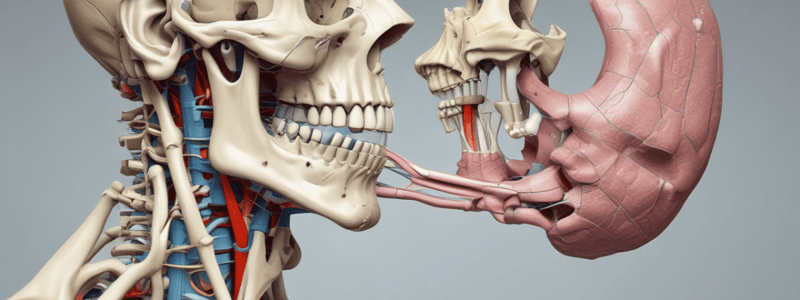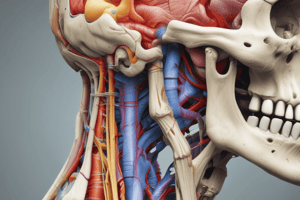Podcast
Questions and Answers
What is the name of the structure that surrounds the temporomandibular joint?
What is the name of the structure that surrounds the temporomandibular joint?
- Articular tubercle
- Retrodiscal tissue
- Meniscus
- Capsule (correct)
Where is the capsule of the temporomandibular joint attached superiorly?
Where is the capsule of the temporomandibular joint attached superiorly?
- Meniscus
- Articular tubercle and margins of the mandibular fossa (correct)
- Neck of the mandible
- Retrodiscal tissue
What is the purpose of the meniscus in the temporomandibular joint?
What is the purpose of the meniscus in the temporomandibular joint?
- To act as a shock absorber and distribute forces (correct)
- To provide lubrication for the joint
- To connect the capsule to the mandible
- To provide a pathway for nerves and blood vessels
Which of the following structures is NOT a component of the temporomandibular joint?
Which of the following structures is NOT a component of the temporomandibular joint?
What is the role of the retrodiscal tissue in the temporomandibular joint?
What is the role of the retrodiscal tissue in the temporomandibular joint?
Which of the following imaging modalities is used to visualize the temporomandibular joint (TMJ) in both the closed- and open-mouth positions?
Which of the following imaging modalities is used to visualize the temporomandibular joint (TMJ) in both the closed- and open-mouth positions?
What type of anatomical structures are depicted in the images labeled A–D?
What type of anatomical structures are depicted in the images labeled A–D?
What is the primary function of the temporomandibular joint?
What is the primary function of the temporomandibular joint?
What type of nerve provides innervation to the temporomandibular joint?
What type of nerve provides innervation to the temporomandibular joint?
What does the letter 'E' in the content represent?
What does the letter 'E' in the content represent?
What is the primary function of the muscles shown in (C)?
What is the primary function of the muscles shown in (C)?
Which of the following best describes the movement of the mandible when opening the mouth?
Which of the following best describes the movement of the mandible when opening the mouth?
What can be inferred about the temporomandibular joint from the diagram?
What can be inferred about the temporomandibular joint from the diagram?
Which of the following muscles is NOT shown in diagram (C)?
Which of the following muscles is NOT shown in diagram (C)?
What is the direction of the force exerted by the muscles of mastication on the mandible?
What is the direction of the force exerted by the muscles of mastication on the mandible?
What is the primary function of the lateral temporomandibular ligament?
What is the primary function of the lateral temporomandibular ligament?
What might happen if a severe blow falls on the chin in the absence of a strong lateral temporomandibular ligament?
What might happen if a severe blow falls on the chin in the absence of a strong lateral temporomandibular ligament?
What is the benefit of the lateral temporomandibular ligament's strength?
What is the benefit of the lateral temporomandibular ligament's strength?
During what type of event might the lateral temporomandibular ligament be particularly important?
During what type of event might the lateral temporomandibular ligament be particularly important?
What is the consequence of the lateral temporomandibular ligament's strength in the context of a severe blow to the chin?
What is the consequence of the lateral temporomandibular ligament's strength in the context of a severe blow to the chin?
What is the primary obstacle to posterior dislocation of the joint?
What is the primary obstacle to posterior dislocation of the joint?
What is the significance of the post glenoid tubercle in relation to joint dislocation?
What is the significance of the post glenoid tubercle in relation to joint dislocation?
What is responsible for resisting posterior dislocation of the joint, in addition to the post glenoid tubercle?
What is responsible for resisting posterior dislocation of the joint, in addition to the post glenoid tubercle?
Posterior dislocation of the joint is:
Posterior dislocation of the joint is:
What two structures work together to resist posterior dislocation of the joint?
What two structures work together to resist posterior dislocation of the joint?
Flashcards are hidden until you start studying
Study Notes
The TMJ Capsule
- Surrounds the joint and attaches to the articular tubercle and margins of the mandibular fossa above
- Attaches to the neck of the mandible below
TMJ Anatomy
- Consists of the temporomandibular joint, meniscus, and retrodiscal tissue
- Has a lateral temporomandibular ligament that prevents posterior dislocation of the mandible
TMJ Function
- Allows for opening and closing of the mouth (shown in A and B anatomical and CT images)
- Muscles of mastication attach to the mandible and have specific directions of action (shown in C)
TMJ Safety Features
- Post glenoid tubercle resists posterior dislocation of the mandible
- Strong intrinsic lateral ligament prevents posterior dislocation of the mandible and fracture of the tympanic plate
Studying That Suits You
Use AI to generate personalized quizzes and flashcards to suit your learning preferences.




